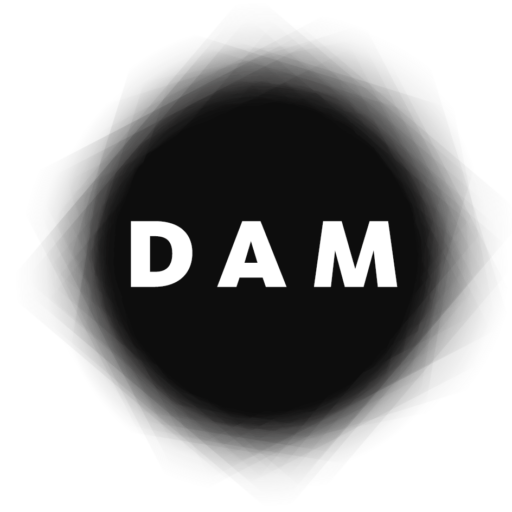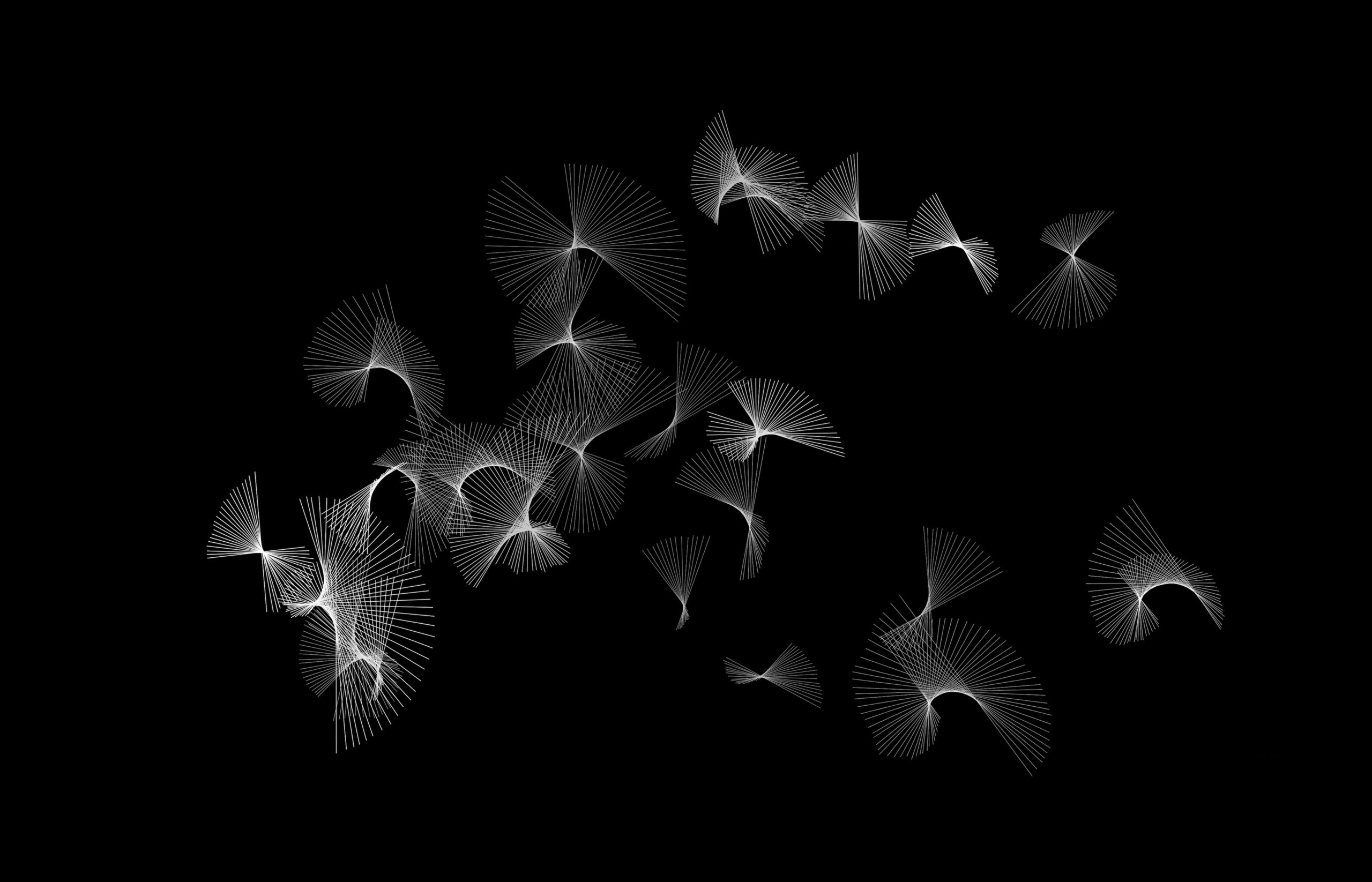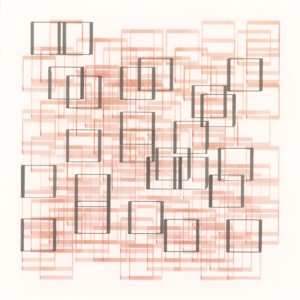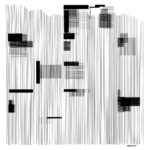
Frieder Nake is one of the three pioneering artists who showed their work in the first exhibitions of computer art in 1965. In 1971 he decided not to produce any more computer art and focused on his teaching and research activities in digital art. He is widely considered as a figure of reference in computer-generated art.
Further reference:
compArt
Recent works
Artworks created by Frieder Nake since 2010, for his group and solo exhibitions in art galleries.
Generative Aesthetics (1968-69)
This series was created with a program developed by Nake, taking inspiration from the theory of information aesthetics. Starting from a set of data, it tried to construct an image following a set of conditions described in the data. The artist run a series of experiments but finally discarded the program. Only two prints were produced, one of which is lost, and the other is in the collection Etzold at Museum Abteiberg in Mönchengladbach, Germany.
Matrix multiplication (1967-68)
This portfolio is made of three separate series, which were generated from a square matrix produced by Nake on a Telefunken T4 computer. The matrix was multiplied successively by itself, creating new matrices that translated into images made of visual signs of a particular form and colour. Given that Nake used random number generation in this work during this period, the multiplication process was probably partly automated. The portfolio was published by the artist Hansjörg Mayer in an edition of forty (Spalter Digital).
Walk-Through Raster (1966)
In 1966, Nake used the Walk-through-Raster software in the ALGOL 60 programming language to create as series of computer-generated drawings on paper. The drawings were produced by a ZUSE-Graphomat Z64.
The program used a repertoire of signs that were placed on a grid. A function selected one sign from the repertoire and another function selected the following sign based on the previous one and applying probability distribution. In this manner, a chain of signs was generated. The second operation of the program consisted in mapping the chain of signs into the cells of the picture plane. The first sign of the chain was put into the top left-most cell of the picture plane. The second sign of the chain was placed into the next cell, and so forth, until all signs had been put into the picture’s cells. This mapping operation was carried out according to a specific mapping mode.
For a more detailed description, read this short essay by Frieder Nake.
compArt ER56 (1963-65)
This phase refers to the artworks created by Frieder Nake using an electronic computer ER 56, which was installed in the Institute for Applied Mathematics in 1959. Among others, Nake created the series Zufälliger Polygonzug, Geradenscharen, and Rechteckschraffuren, between 1964 and 1965.
.
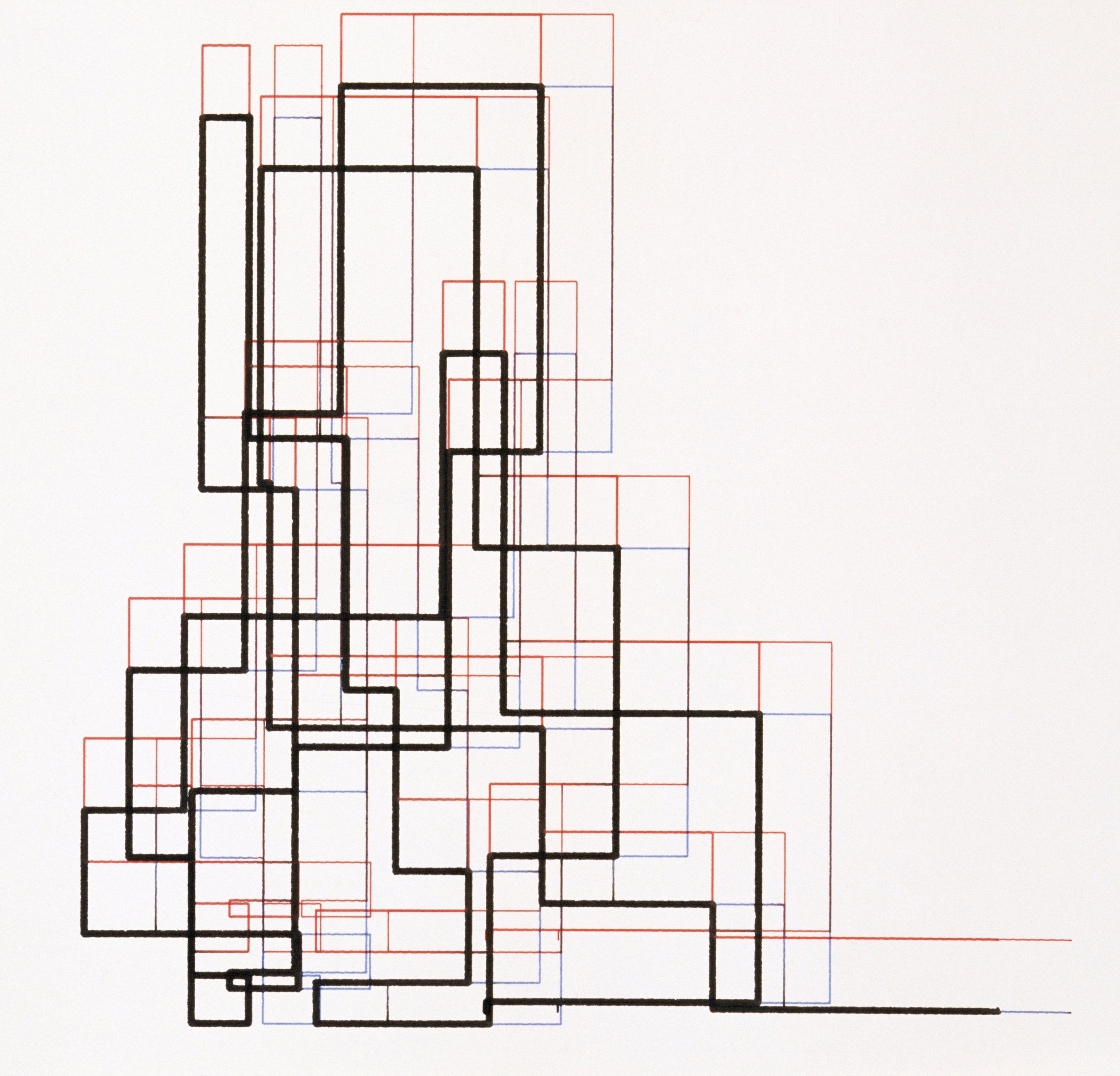
There Should Be No Computer-Art
Frieder Nake
Page (Bulletin of the Computer Arts Society, London) No. 18, Oct. 1971, 1-2. (excerpt)
Computers ought not to be used for the creation of another art fashion.
Questions like ” is a computer creative” or ” is a computer an artist” or the like should not be considered serious questions, period. In the light of the problems we are facing at the end of the 20th century, those are irrelevant questions.
Computers can and should be used in art in order to draw attention to new circumstances and connections and to forget ” art” .
There is no need for the production of more works of art, particularly no need for ” computer art” . Art (better: the aesthetic object) comes afterwards (but it does come). Aesthetic information as such is interesting only for the rich and the ruling. For the others (and they are in the majority) it comes ” with” . Namely with other information. Thus, the interest in computers and art should be the investigation of aesthetic information as part of the investi· gation of communication. This investigation should be directed by the needs of the people.
We should not be interested in producing some more nice and beautiful objects by computers. We should be interested in producing a film on, say, the distribution of wealth. Such a film is interesting because of its content; the interest in the content is enhanced by an aesthetically satisfying presentation. That is, the role of the computer in the production and presentation of semantic information which is accompanied by enough aesthetic information is meaningful; the role of the computer in the production of aesthetic information per se and for the making of profit is dangerous and senseless.
[…]
Reiterating the argument: I don’t see a task for the computer as a source of pictures for the galleries. I do see a task for the computer as a convenient and important tool in the investigation of visual (and other) aesthetic phenomena as part of our daily experience.
As concrete projects to be investigated I propose:
1. The study of the alienation of the artist from his product which is caused by technology in general and by computers in particular (the distance between the artist and his work increases). What are the good, what are the bad effects of the division of labor taking place in art?
2. Investigation of the repertoires of signs used by individual artists and styles in the past and present. Such repertoires have been described occasionally, but not rigorously enough. The emphasis of such a project should be to describe those repertoires (and their various levels) in a way suitable for an application of information aesthetics.
3. Design and performance of experiments to test the significance of aesthetic measures defined so far; perhaps new definition of such measures.
4. Investigation of the importance of aesthetic information in various areas (education, propaganda, environments of work and living). This work would have to be based on a rigorous numerical definition of “aesthetic information” .

Stuttgart (Germany), 1938
Frieder Nake studied mathematics at the Technical University of Stuttgart, where he attended Prof. Max Bense’s lectures on philosophy, semiotics, and aesthetics. In 1964, he created his first computer drawings using a Zuse Graphomat Z64 to which he had access at the Computing Centre of the University. In 1965, he presented his work alongside Georg Nees in one of the three first exhibitions of computer-generated art in history. Titled Computer-Grafik, the show took place at the Wendelin Niedlich Galerie in Stuttgart, from November 5th to the 26th. Between 1966 and 1972 he took part in many exhibitions, among which the seminal Cybernetic Serendipity (ICA, London, 1968), curated by Jasia Reichardt, or Proposal for an Experimental Exhibition at the 35th Venice Biennale. In 1971 he decided not to produce any more computer art, which he considered would end up catering to the art market. Instead, he focused on research in computer art, computer graphics, and digital media at several universities, such as the University of Toronto (1968), University of Bremen (1972), University of Vienna (1988), University of Oslo (1995), University of Colorado at Boulder (1997, 1998), Northwest Institute of Mechanical and Electrical Engineering, Xian, Shaanxi, China (2000), University of Aarhus, Denmark (2000, 02, 04, 05), International School of New Media at Lübeck (2003, 05, 06, 07), University of Basel (2007), Donau-University Krems (2007, 09), and the University of Costa Rica (2009). In 1999, he co-founded with Susanne Grabowski and Matthias Krauß the project compArt: a space for computer art (later compArt: Centre of Excellence Digital Art), a large online database dedicated to early digital art. Widely recognised as one of the “three big N´s”, the pioneers who first exhibited algorithmic art in 1965 (the other two being Georg Nees and A. Michael Noll), Frieder Nake is a figure of reference in computer art, who continues to exhibit his work regularly as an artist represented by DAM Gallery (Berlin) while pursuing his teaching and research activities as a professor of computer science at the University of Bremen and the University of the Arts in Bremen.
Frieder Nake has taken part in all the major shows on computer art. Among the most notable exhibitions are Cybernetic Serendipity (ICA, London, 1968), curated by Jasia Reichardt; Kunst und Computer (Viennna Sparkasse, 1969), curated by Otto Beckmann; 25 Jahre Computerkunst – Grafik, Animation und Technik (BMW Pavilion, Munich, 1989), curated by Herbert W. Franke; Ex Machina – Frühe Computergrafik bis 1979 (Kunsthalle Bremen, 2007), curated by Wulf Herzogenrath and Barbara Nierhoff-Wielk; and Drawing with Code: Works from the Anne and Michael Spalter Collection (DeCordova Sculpture Park and Museum, Lincoln, Massachusetts, 2011), curated by George Fifield. In 2004, a retrospective of his work took place at Kunsthalle Bremen and ZKM Karlsruhe under the title Frieder Nake: Die präzisen Vergnügen, followed by a large number of one-person shows such as compART, Algorithmus und Zufall (DAM Gallery Berlin, 2005), Licht ins Dunkel, 25 x 50 Jahre Computerkunst (HFK Bremen, 2013), No Message Whatsoever: Frieder Nake & Friends (DAM Gallery, Berlin, 2013) and 79 + 364 (DAM Gallery, Berlin, 2019).
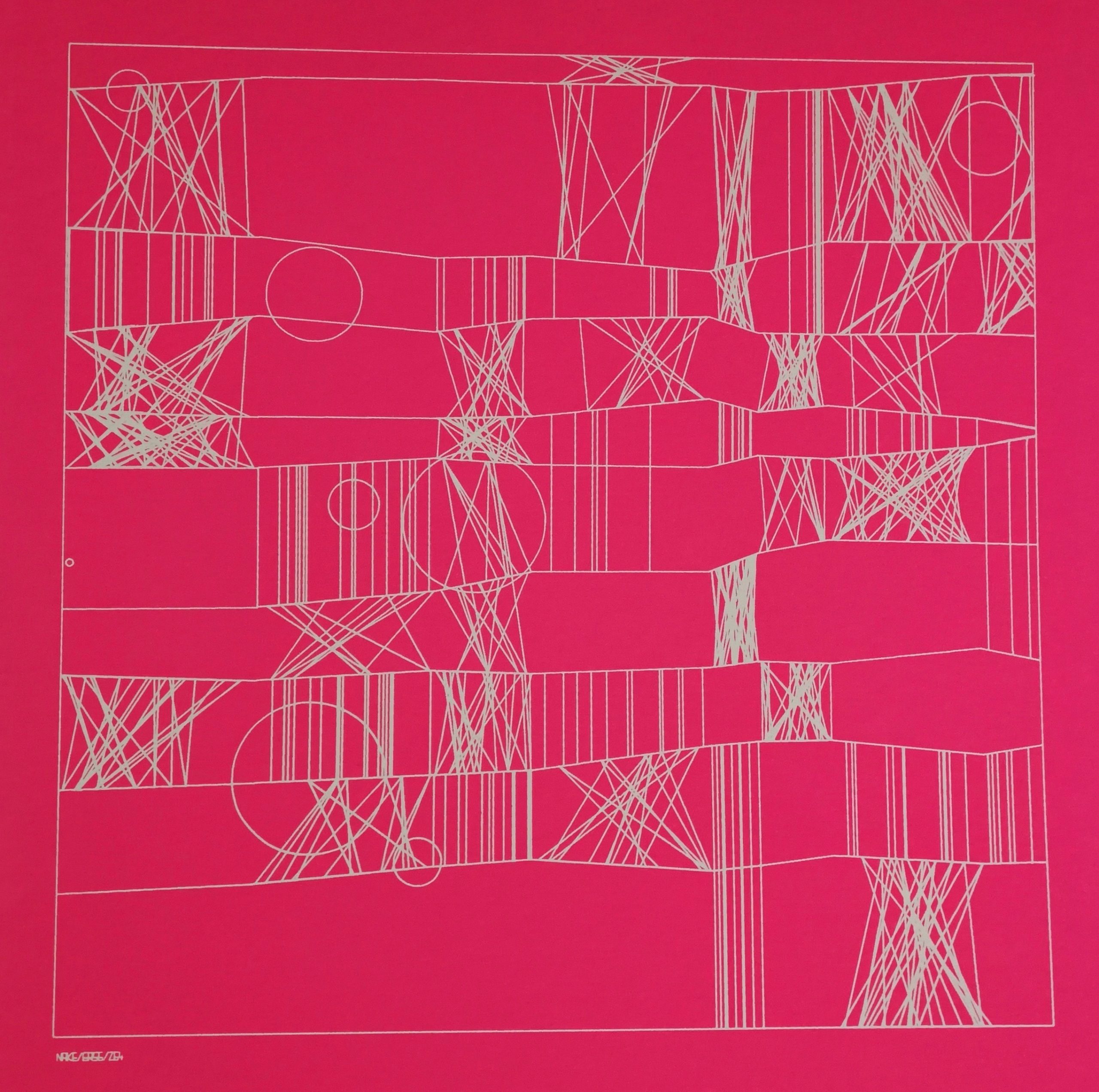
Nake, F. (1966). futura 13. computergrafik. Stuttgart: Edition Hans-Jörg Mayer. [DE]
–– (1971). There Should Be No Computer-Art. Bulletin of the Computer Arts Society, London, No. 18, Oct. 1971, 1-2. – Reprinted in: A. Altena, L. van der Velden (eds.): The anthology of computer art. Amsterdam: Sonic Acts 2006, 59-60. [EN]
–– (2012). Construction and Intuition: Creativity in Early Computer Art. In: McCormack, J. and d’Inverno, M. Computers and Creativity. Berlin: Springer Verlag.
–– (2019). Georg Nees & Harold Cohen: Re:tracing the origins of digital media. In: O. Grau, J. Hoth & E. Wandl-Vogt (eds.) Digital Art through the Looking Glass. New strategies for archiving, collecting and preserving in digital humanities. Donau: Donau-Universität, p.30. [EN]
–– (2019). Harold Cohen. Einzigartig. Exhibition catalogue. Berlin: DAM Gallery. [DE]
Bense, M. (1965). Computergrafik bei Wendelin Niedlich. Speech given at the opening of the exhibition Computer-Grafik. [DE]
–– (1965) Computergrafik. Re-publication of the original text in Semiosis, vol 3/4, 1990. [DE]
Munk, B. (2019). Frieder Nake. About Algorithmic Art. Lines Fiction. [EN]
Smith, Glenn W. (2019). An Interview with Frieder Nake. An Interview with Frieder Nake. Arts 2019, 8(2), 69. [EN]
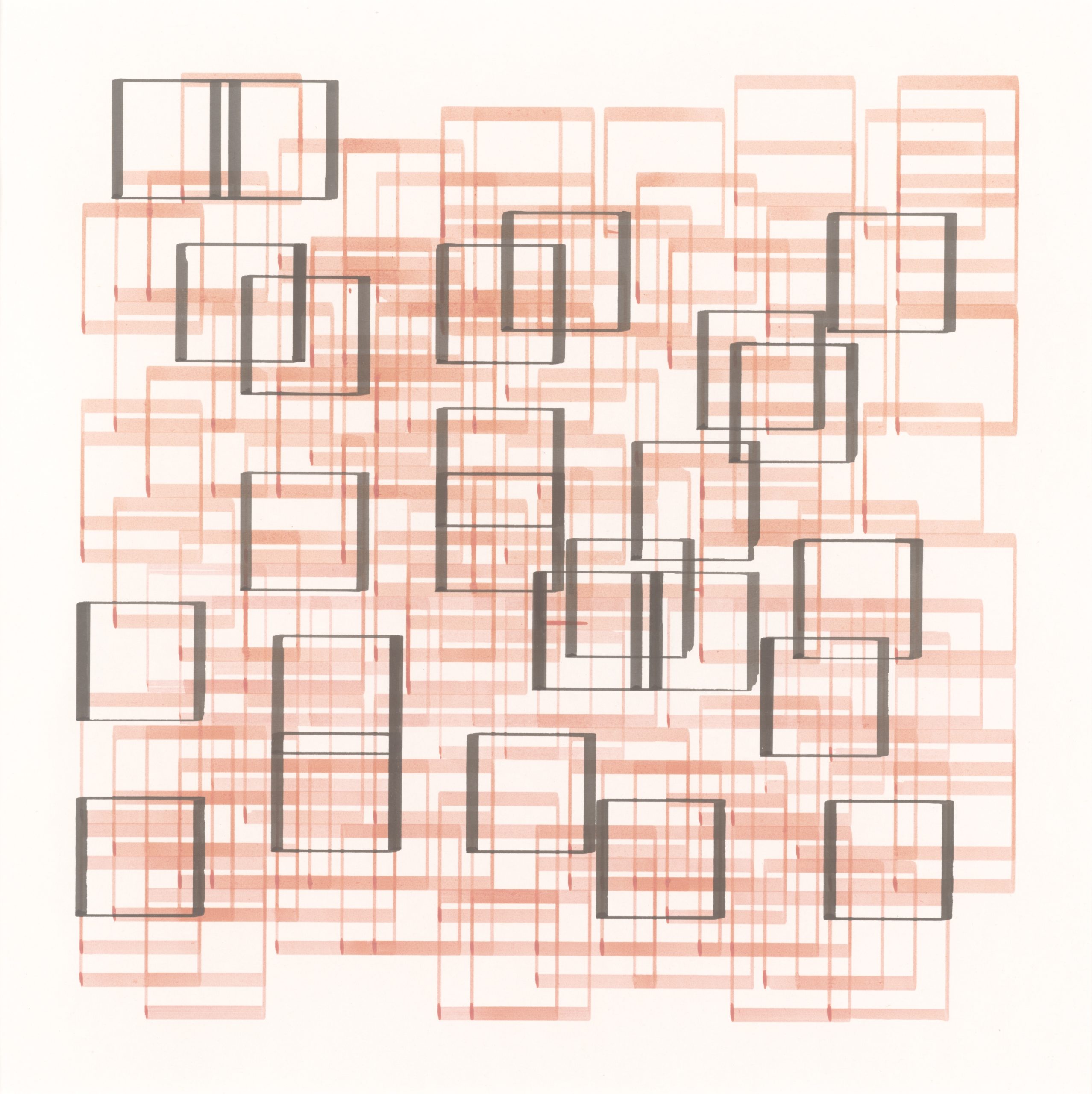
Publications (selection)
2019
Frieder Nake: Harold Cohen. Einzigartig. internal publication, 2019.
2018
Frieder Nake: Bieder reimt sich auch auf Mieder. Was soll man machen, wenn einer so heißt, wie er heißt? Worte zu einer Katastrophe, hier verkleidet als Nachwort oder so was. In Werner Biedermann: Mit an Sinnlichkeit grenzender Wahrscheinlichkeit. Werkkatalog. Duisburg: Edition Kinemathek 2018. 151-155.
Frieder Nake: The pioneer of generative art: Georg Nees. Leonardo 51, 3 (June 2018) 277-279.
2010
Frieder Nake: Paragraphs on Computer Art, Past and Present. British Computer Society, Swinton, UK.
2007
Frieder Nake, Susanne Grabowski, Matthias Krauß: Allenthalben Algorithmen. Von Ästhetik und von Zeichen, von Kunst und von Wissenschaft. In: Dieter Mersch, Michaela Ott (Hrsg.): Kunst und Wissenschaft. München: Wilhelm Fink 2007. 195-224, 285.
2005
Leslie Mezei: Frieder Nake and Peter Weibel. Springer Verlag, Wien/New York, 2005.
1993
Die erträgliche Leichtigkeit der Zeichen. Ästhetik, Semiotik, Informatik. Agis, Baden-Baden.
Die präzisen Vergnügen. Frieder Nake and Diethelm Stoller. Sautter & Lackmann, Hamburg.
1985
20 Jahre Computergrafik. Frieder Nake. In: Umbruch – Zeitschrift für Kultur: „Schnittstellen“. Hager, Frankfurt.
1974
Frieder Nake: Ästhetik als Informationsverarbeitung. Grundlagen und Anwendungen der Informatik im Bereich ästhetischer Produktion und Kritik. Springer Verlag, Wien/ New York, 1974
1972
Art Ex Machina (Portfolio). Frieder Nake u.v.m., Gilles Gheerbrant, Montréal, Canada.
1971
Frieder Nake: There Should Be No Computer-Art. Page (Bulletin of the Computer Arts Society, London) No. 18, Oct. 1971, 1-2. – Reprinted in: A. Altena, L. van der Velden (eds.): The anthology of computer art. Amsterdam: Sonic Acts 2006, 59-60.
1968
Frieder Nake: Erzeugung ästhetischer Objekte. In: Rul Gunzenhäuser (Hrsg.), Nicht-numerische Informationsverarbeitung. Springer Verlag, Vienna.
1967
Frieder Nake: Teamarbeit zwischen Künstler und Computer. Format 11 (July 1967) 38-39. – Also in: Jürgen Claus: Expansion der Kunst. Reinbek: Rowohlt 1970. 127-129. And also in: Ästhetik als Programm. Kaleidoskopien 5 (2004) 220-225.
Frieder Nake u.v.m. Kunst aus dem Computer (Exakte Ästhetik 5). Nadolski, Stuttgart.
1966
Frieder Nake: futura 13. Computergrafik. Edition Hans-Jörg Mayer, Stuttgart.
Herstellung von zeichnerischen Darstellungen, Tonfolgen und Texten mit elektronischen Rechenanlagen. Darmstadt.
Unpublished
Frieder Nake, Susanne Grabowski: Think the image, don’t make it! On algorithmic thinking, art education, and re-coding.
Journal of science and technology of the arts, 9 (3), 21-31.
